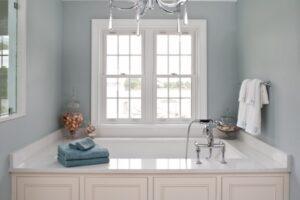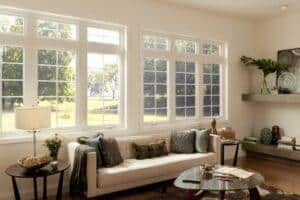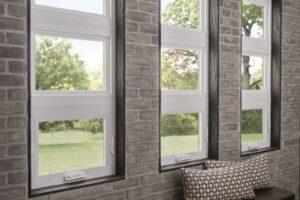Selecting the right types of windows for your home can significantly impact its energy efficiency, appearance, and overall functionality. From double-hung and casement to bay windows and sliding options, homeowners have a wide range of styles to choose from, each with its unique features and benefits. Energy-efficient windows with low-E coatings, argon gas fills, and proper installation can help reduce energy costs while providing insulation and noise reduction.
When choosing windows, it’s crucial to consider factors like climate, material durability, maintenance requirements, and performance metrics like U-factor and solar heat gain coefficient. Some homeowners may opt for impact-resistant or hurricane windows in regions prone to severe weather, while others prioritize storm windows or bay windows for aesthetic appeal. Ultimately, the right window type should align with your specific needs, preferences, and budget constraints.

Double-hung windows offer several advantages that make them a popular choice for homeowners. These windows have two operable sashes, allowing both the top and bottom sections to move vertically, making them easier to clean. Additionally, they provide more ventilation options, as air can travel through both the top and bottom sashes.
|
Pros |
Cons |
|---|---|
|
Easier to clean |
Less energy-efficient than single-hung windows |
|
More ventilation options |
More expensive to purchase and install |
|
Safer for homes with children |
Require more maintenance over time |
|
Versatile design options |
Potential for air leaks |
With proper installation and maintenance, double-hung windows can provide a stylish and functional solution for many homeowners.

Casement windows offer a distinct set of advantages that make them a popular choice for many homeowners. Unlike double-hung windows, casement windows are hinged on one side and open outward, allowing for maximum ventilation and an unobstructed view.
|
Pros |
Cons |
|---|---|
|
Maximized ventilation |
Potential for obstructed views when open |
|
Tight sealing against elements |
Require more wall space for opening |
|
Compatible with various grid patterns |
More expensive than some other window styles |
When selecting casement windows, it’s essential to consider the overall style of your home and how the window design complements the aesthetic. While they offer excellent ventilation and weather protection, casement windows may require more wall space and can obstruct views when fully open.

Sliding windows, also known as horizontal rolling windows, offer homeowners a unique combination of benefits. With two or more sashes that open horizontally by sliding left and right along grooves in the frame, these windows provide unobstructed views and allow abundant natural light to fill the interior spaces. Their clean, contemporary look suits most modern homes, making them a popular choice for homeowners seeking a sleek and stylish aesthetic.
In addition to their visual appeal, sliding windows are renowned for their energy efficiency. By reducing air and water leaks, they can contribute to lowering utility bills and improving a home’s overall energy performance. Furthermore, these windows require minimal maintenance, with features like tilt latches for easy exterior glass cleaning, making them a convenient option for busy homeowners.
Sliding windows are versatile and can be tailored to suit various needs. They are well-suited for rooms with low ceilings, small spaces, large rooms, and areas with limited ventilation. Homeowners can choose from a variety of sizes, materials, and hardware finishes, allowing for full customization to complement their home’s architectural style. Strategically placed sliding windows can also facilitate effective home ventilation by allowing fresh outdoor air to circulate freely.
Bay and bow windows are popular choices for homeowners seeking to add architectural interest, natural light, and extra living space to their homes. While they share some similarities, these window styles have distinct features that set them apart.
Bay windows consist of three windows – two angled operable windows with one fixed picture window in the middle. They protrude outward from the exterior wall, creating an angular, boxy shape. Key features of bay windows include:
Bow windows, on the other hand, consist of four or more identical windows that create a subtle curved shape. They sweep away from the wall in a graceful arc, providing a more panoramic view. Notable aspects of bow windows include:
|
Bay Windows |
Bow Windows |
|---|---|
|
Angled, boxy shape |
Curved, arched shape |
|
3 windows (2 operable, 1 fixed) |
4 or more identical windows |
|
Provide extra floor space |
Enhance the feeling of spaciousness |
|
Suitable for various home styles |
Often more expensive due to custom work |
Both bay and bow windows are available in various materials, including wood, fiberglass, and vinyl, and can be customized to fit different budgets and architectural styles. Whether you prioritize additional living space, natural light, or a unique aesthetic, these window styles offer versatile solutions for enhancing your home’s interior and exterior appeal.

Awning windows offer a unique combination of functionality and style that can enhance the overall aesthetic and ventilation of your home. These windows are hinged at the top and open outward, typically wider than they are tall. When opened, they create an angled awning that allows for excellent ventilation while preventing rain or debris from entering the interior space.
One of the key benefits of awning windows is their ability to provide ample airflow without compromising on security or exposing your home to the elements. They can open up to 45 degrees from the bottom, allowing fresh air to circulate while keeping out rain, snow, or strong winds. This feature makes them an ideal choice for bathrooms, kitchens, and bedrooms, where ventilation is essential but privacy and protection are equally important.
Awning windows are designed to seamlessly blend with the overall architecture of your home. Their sleek and contemporary look can complement various architectural styles, adding an attractive and functional element to your exterior. Additionally, they can be combined with larger, stationary windows, such as picture windows, to provide ventilation without obstructing the view.
|
Pros |
Cons |
|---|---|
|
Excellent ventilation |
Exposure to elements may require more frequent cleaning |
|
Protection from rain and debris |
Potential for increased maintenance and repairs |
|
Seamless integration with home architecture |
Limited opening angle compared to other window styles |
|
Easy operation and maintenance |
Whether you prioritize ventilation, security, or aesthetic appeal, awning windows offer a versatile solution that can enhance the functionality and charm of your living spaces.
When it comes to selecting the right window types for your home, the options are plentiful, each offering unique benefits and features. From the traditional double-hung and casement windows to the modern sliding and awning styles, homeowners can choose the perfect combination that aligns with their practical needs, aesthetic preferences, and energy efficiency goals. As you embark on this journey, consider factors such as ventilation requirements, maintenance concerns, and the overall architectural style of your home to make an informed decision.
Ultimately, the window selection process is a balance between functionality and design. Whether you prioritize energy savings, unobstructed views, or added living space, there is a window type that can meet your specific requirements. By carefully evaluating your needs and consulting with professionals, you can transform your living spaces into inviting, comfortable, and visually appealing environments that enhance your home’s overall appeal and value.
1. How should I select the appropriate window style for my home?
When choosing window styles, it’s crucial to consider the architectural style of your home and, if you’re renovating, the historical era of the property. Incorrect window choices can significantly detract from your home’s overall aesthetic and reduce its curb appeal.
2. What are the common styles of windows available for homes?
There are seven popular types of windows used in residential settings:
3. What considerations are important when selecting windows for a new house?
Choosing windows for a new construction involves careful consideration of several factors including style, finish, functionality, shape, and material composition. Windows and doors are among the most critical elements in a building’s design, impacting both aesthetics and functionality.
STH Windows and Doors is your trusted partner in window and door sales and installation, servicing the entire Tampa Bay area including:
Downtown Tampa | Clearwater | Harbour Island Hyde Park | Brandon | St. Petersburg | Wesley Chapel | South Tampa | Lutz | Temple Terrace Plant City | The Heights | Westshore
8414 Sabal Industrial Blvd
Tampa, FL 33619
Monday
Tuesday
Wednesday
Thursday
Friday
9AM – 5PM
9AM – 5PM
9AM – 5PM
9AM – 5PM
9AM – 5PM
Privacy Policy | Copyright 2024 | License # SCC131152895